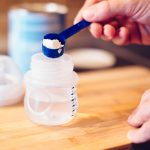 When it comes to bottle-feeding your baby, chances are you’re overwhelmed by the baby bottle options. So many materials, shapes, and sizes. How on earth do you choose?
When it comes to bottle-feeding your baby, chances are you’re overwhelmed by the baby bottle options. So many materials, shapes, and sizes. How on earth do you choose?
There’s no expert-approved, gold standard baby bottle. In the end, it comes down to which ones work well for your baby (and you!). That said, you have to start somewhere. So settle in and read on; here are the baby bottle basics.
Highlights:
|
First Tip for Choosing Baby Bottles
While we do recommend you stock up on certain things before your baby arrives, bottles isn’t one of them. That’s because even though some bottles are marketed as magical feeding unicorns, the ultimate decision-making factor will be which ones get the thumbs-up from your baby. So, start out with just a few (maybe even two different types). That way you’re not stuck with a full stock of bottles that may get the thumbs-down from your little one.
Now let’s get to those bottle basics.
Bottle Material
Bottles can be made of plastic, silicone, glass, or stainless steel.
Plastic – Pros of plastic bottles are that they’re lightweight and won’t break if dropped. A downside is that they deteriorate over time and need to be replaced periodically (signs of deterioration include scratches, cracks, leaks, discoloration, and bad odor). If you decide to go the plastic bottle route, be sure they’re new. Older plastic bottles may contain BPA (or bisphenol A – a potentially harmful substance no longer allowed in baby products).
While new plastic baby bottles are generally considered safe, it’s worth noting that the American Academy of Pediatrics recently came out with a statement on food-additives that raises questions about mixing plastic and food (including infant formula and pumped human milk).
Silicone – Bottles made from food-grade silicone are BPA-free, flexible, and lightweight. Not only will they not break if dropped, they’ll probably bounce!
Glass – Glass bottles are naturally BPA-free and durable, but heavy and breakable. Some glass bottles come with silicone sleeves to protect from breakage.
Stainless Steel – Stainless steel bottles are BPA-free, lightweight AND durable. But you’ll pay for it, literally speaking; they’re the priciest on the shelf. Another thing to keep in mind is that unlike other bottle materials, you can’t see how much liquid is in them from the outside.
Disposable Plastic Liners – These are convenient, but they’re costly and can only be used once. To use, you fill them, pop in a dedicated bottle, and toss at the end of the feeding.
Bottle Shapes
In general, bottles come in the following shapes:
Standard – Tall and straight, and easy to fill and clean.
Angled – Bent at the neck so milk collects at the bottom, which may prevent your baby from swallowing air. The downside is that they may be more cumbersome to fill and clean.
Wide – Designed to hold wide, short nipples that mimic a breast.
Bottle Size
Bottles generally come in small (around 4 ounces) and large (around 8 ounces) sizes. Small sizes are convenient during the newborn days, when babies drink about 2-3 ounces per feed. But babies grow out of small bottles quickly, so you can save money by skipping them and using large bottles from the get-go if you wish.
Nipple Materials
In general, bottle nipples are made of latex or silicone. Latex is softer and more flexible, but wears out more quickly and some babies are allergic to it. Silicone is firmer than latex, but more durable. Keep an eye on your bottle nipples and replace them if they show signs of wear and tear such as thinning, or becoming sticky, discolored, cracked or torn. Another sign it’s time for a new nipple is if the milk starts flowing faster than it was before.
Nipple Shapes
Most nipples shapes fall into one of three categories:
- Narrow and longer (traditional)
- Wide and shorter (designed to be breast-like)
- Flat on one side (designed to mimic sucking on a human breast and/or be a better fit for baby’s mouth)
Nipple Levels
Nipple levels correspond with how quickly milk flows out. As your baby grows and can handle faster milk flow, you can progress through higher levels.
Bottle Extras
Venting – Some bottles and/or nipples are “vented,” or designed to prevent babies from swallowing air. This, in turn, may reduce gassiness and fussiness. A potential downside to vented bottles is that they may involve extra parts, which means extra things to wash and assemble.
Breast Pump Bottles – If you plan to pump and bottle-feed breastmilk, you may find a breast pump with bottles that do double duty: They fit onto the pump to catch your milk AND they come with nipple tops for later feeding.
Now, happy bottle shopping!








